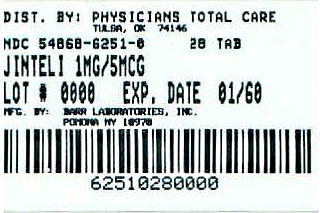Jinteli | Norethindrone Acetate And Ethinyl Estradiol Tablet while Breastfeeding

What is Jinteli | Norethindrone Acetate And Ethinyl Estradiol Tablet used for?
Can I continue breastfeeding if I am using Jinteli | Norethindrone Acetate And Ethinyl Estradiol Tablet? How long does it stays in breast milk?

H. Nursing Mothers Estrogen administration to nursing mothers has been shown to decrease the quantity and quality of the milk. Detectable amounts of drug have been identified in the milk of mothers receiving these drugs. Caution should be exercised when norethindrone acetate and ethinyl estradiol is administered to nursing mothers.
Jinteli | Norethindrone Acetate And Ethinyl Estradiol Tablet Breastfeeding Analsys
Norethindrone acetate while Breastfeeding
SafeCAS Number: 68-22-4
Progestin contraceptive used as a single product or linked to ethinyl estradiol (see Etinilestradiol + Norethindrone). Norethindrone is a progestin derivative of 19-nortestosterone. It is excreted in breast milk in clinically significant amount and no problems have been observed in infants whose mothers took it. Plasma levels of these infants were undetectable or very low. Progestin is generally considered contraceptive drugs of choice during lactation since it neither alter the quantity and composition of milk nor cause side effects on both growth of infants and the duration of breastfeeding.Published study results have shown protection against breast bone mass loss with the use of progestin-only contraceptives. For the first 6 weeks postpartum, non-hormonal methods are of choise. There is a debate on the role of progestin-related drugs in decreasing milk production when used before lactation has been fully established. The American Academy of Pediatrics states that this medication is usually compatible with breastfeeding.WHO List of Essential Medicines 2002: rates it as compatible with breastfeeding after the 6th postnatal week.
Ethinyl estradiol while Breastfeeding
Low RiskCAS Number: 57-63-6
Synthetic estrogen that has a similar action as estradiol. Used in combination with progestogens for contraception. Ethinylestradiol is excreted in small or no amount into breast milk.There is evidence (albeit inconsistent) that estrogen-containing pills may decrease milk production, especially during the first few weeks postpartum with a daily dose above 30 micrograms of ethinyl estradiol.It may reduce the protein content of the milk.No problems have been observed in infants whose mothers were treated, except some cases of transient gynecomastia in infants whose mothers were receiving a higher dose than usual. During lactation progestin-only drugs are preferred or in combination with estrogen for birth control, but whatever, the ones with the lower doses of estrogen should be used.For the first 6 weeks postpartum, non-hormonal methods are of choise.
Jinteli | Norethindrone Acetate And Ethinyl Estradiol Tablet Breastfeeding Analsys - 2
Norethindrone acetate while Breastfeeding
CAS Number: 68-22-4
This record contains information specific to norethindrone used alone. Readers with an interest in a combination oral contraceptive should consult the record entitled, "Contraceptives, Oral, Combined." Poor to fair quality evidence indicates that norethindrone does not adversely affect the composition of milk, the growth and development of the infant or the milk supply.[1][2][3][4] Some evidence indicates that progestin-only contraceptives may offer protection against bone mineral density loss during lactation, or at least do not exacerbate it.[5][6][7] Although nonhormonal methods are preferred during breastfeeding, progestin-only contraceptives such as norethindrone are considered the hormonal contraceptives of choice during lactation. Fair quality evidence indicates that norethindrone does not adversely affect the composition of milk, the growth and development of the infant or the milk supply. Expert opinion holds that the risks of progestin-only contraceptive products usually are acceptable for nursing mothers at any time postpartum.[8][9]
Ethinyl estradiol while Breastfeeding
CAS Number: 57-63-6
This record contains information specific to ethinyl estradiol used alone. Users with an interest in an oral contraceptive should consult the record entitled, "Contraceptives, Oral, Combined."There is little information available on the use of ethinyl estradiol alone during breastfeeding. Levels in milk appear to be low. Based on studies on oral contraceptives that contain ethinyl estradiol, immediate side effects such as breast enlargement appear to occur rarely. It seems likely that doses of 30 mcg daily or greater can suppress lactation. The magnitude of the effect on lactation likely depends on the dose and the time of introduction postpartum, but data are not adequate to accurately define these doses and times.
What should I do if I am breastfeeding mother and I am already exposed to Jinteli | Norethindrone Acetate And Ethinyl Estradiol Tablet?
During whole lactation period you shall first discuss with your doctor and then together you shall decide whether you shall take that drug or not however if you have already taken Jinteli | Norethindrone Acetate And Ethinyl Estradiol Tablet then you shall inform your doctor, But you should not be worried too much as Jinteli | Norethindrone Acetate And Ethinyl Estradiol Tablet comes in category of low risk drug.
My health care provider has asked me to use Jinteli | Norethindrone Acetate And Ethinyl Estradiol Tablet, what to do?
Jinteli | Norethindrone Acetate And Ethinyl Estradiol Tablet comes in category of low risk and if your doctor is aware that you are breastfeeding it should be ok to use
If I am using Jinteli | Norethindrone Acetate And Ethinyl Estradiol Tablet, will my baby need extra monitoring?
Not much
Who can I talk to if I have questions about usage of Jinteli | Norethindrone Acetate And Ethinyl Estradiol Tablet in breastfeeding?
US
National Womens Health and Breastfeeding Helpline: 800-994-9662 (TDD 888-220-5446) 9 a.m. and 6 p.m. ET, Monday through Friday
UK
National Breastfeeding Helpline: 0300-100-0212 9.30am to 9.30pm, daily
Association of Breastfeeding Mothers: 0300-330-5453
La Leche League: 0345-120-2918
The Breastfeeding Network supporter line in Bengali and Sylheti: 0300-456-2421
National Childbirth Trust (NCT): 0300-330-0700
Australia
National Breastfeeding Helpline: 1800-686-268 24 hours a day, 7 days a week
Canada
Telehealth Ontario for breastfeeding: 1-866-797-0000 24 hours a day, 7 days a week
